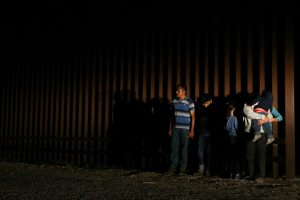As the administration of President Donald Trump started its work to tighten American immigration laws, some U.S. citizens were forced to flee for Canada to avoid separation from their families.
Jacqueline Roby, Communications Advisor for the Canada Border Services Agency, told Grasswire that for the first six months of 2017, the top five countries of origin for asylum-seekers were Haiti, Sudan, Turkey, Eritrea and the United States.
Roby said the Americans seeking refuge in Canada are people who have U.S. nationality by birth.
“They are the children born recently in the U.S. They are children of foreigners,” she said.
Since the beginning of the year, more than 3,350 asylum seekers were apprehended in Quebec province which borders several U.S. states.
Earlier this month, Canadian authorities deployed troops to erect tents for dozens of refugees, mostly from Haiti, who arrive in the country from New York state.
“The tents allow asylum seekers to have temporary shelter against the elements so that the CBSA can continue its orderly processing of asylum claimants when they arrive at the border,” Roby said.
The number of asylum-seekers arriving at the land border fluctuates daily, and the CBSA, along with other partner agencies, regularly adjust their operations to deal with the ongoing situation.
“The Government Operations Centre has been activated to ensure the ongoing coordination of the Government of Canada’s response to the increased numbers of asylum seekers arriving in the Saint-Bernard-de-Lacolle area,” Roby added.
Many of the asylum-seekers choose to enter Canada illegally, since it allows them to avoid provisions under the 2002 Canada-U.S. Safe Third Country Agreement. The deal requires refugees to apply for protection status in the first country they arrive in. Those who have already been to the United States will be returned there, if they try to legally file for a refugee status in Canada.
“While Canada remains open, a welcoming country to people seeking refuge, whatever their ethnicity, background or religion, trying to slip across the border in this way is against the law and not a ‘free ticket’ into Canada. There are rigorous immigration and customs rules to be followed – and make no mistake – we enforce them to safeguard our communities against security risks,” Roby said.
According to data released by the Migration Policy Institute, the number of unauthorized crossings into Quebec jumped 230 percent in January 2017, compared to a year earlier. The increase coincides with the beginning of Trump’s term.
Michelle Mittelstadt, Director of Communications for MPI, told Grasswire that the increased movements are the result both of uncertainty over the future of Temporary Protected Status for Haitian migrants in the United States, and the perception that the country has become a less welcoming place for would-be asylum-seekers and migrants.
The United States granted Haitians temporary protection after the devastating 2010 earthquake. The U.S. Department of Homeland Security may designate a country for the temporary protected status if its citizens are not able to return home safely.
Under the TPS, foreigners cannot be deported from the United States and can legally work in the country. At present, about 46,000 Haitians have TPS status in the United States, according to the MPI.
The Trump administration extended the TPS for Haiti for another six months in May, but it is uncertain that it will be prolonged again.
“Amid uncertainty in the Haitian community over the future of TPS and anxiety more broadly over increased immigration enforcement, more migrants appear to be making the calculus that Canada would be a more hospitable destination,” Mittelstadt said.






